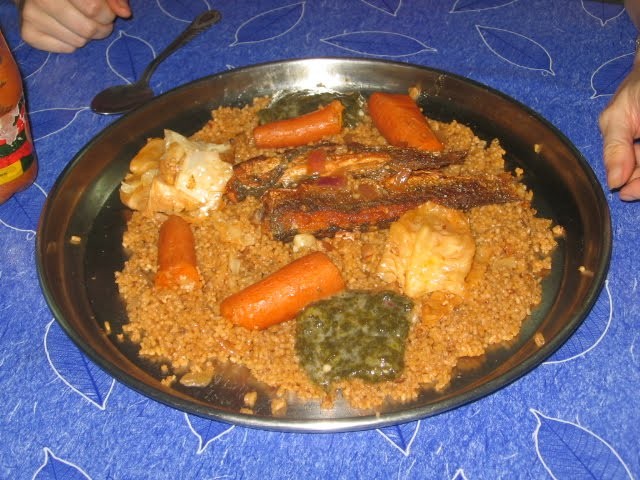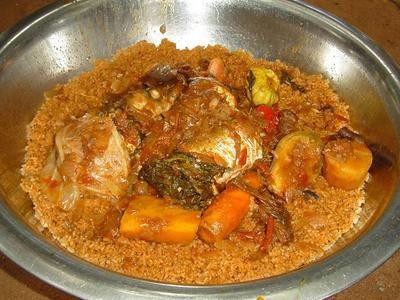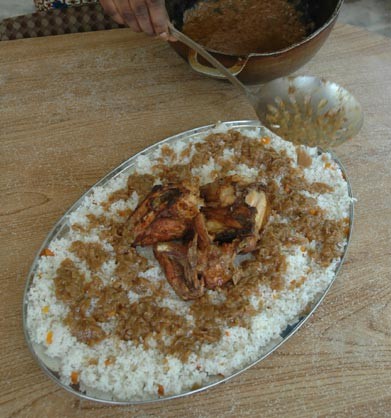Senegalese Cuisine
I would like to write an article specifically on the cuisine as in Senegal I ate very well and I really miss the food there. I am also going to talk about the drinks that I tried.
Typical hot meals
Onion sauce
For all of the dishes that I tried in Senegal, often having rice as a base, there was an onion sauce that I loved. However, I unfortunately have never succeeded in reproducing it to the same standard. The sauce was thick, prepared with lots of onions, oil and bouillon cubes. This sauce was also used to prepare Poulet Yassa (Senegalese Chicken).
Thiéboudieune (rice with fish)
Thiéboudieunne, pronounced tiboujène/tiboujenne, is a rice dish with fish that is always served with the previously mentioned fantastic onion sauce! This dish differs depending on the fish used to make it. I ate it a lot when I was there. Vegetables are in this dish – whole carrots, onions, and I think artichokes (sometimes... or a type of vegetable that looks like an artichoke but doesn’t really taste like one). There was a version with lemons in it, but we didn’t make it like that where I lived. There were sometimes soft potatoes or normal ones in it. Sometimes aubergines were added.


Yassa Poulet
Still the same principle: onions, vegetables and chicken. It was similar to the ‘théboudhienne’ recipe but it did not at all taste the same as fish gave a particular flavour to the rice and chicken gave less. The chicken was stuffed with lots of herbs. It was a bit of a weird flavour. Also, some people had a particular way of cleaning the chicken… with savon du Marseille (Marseille soap) or with bleach... I’m not joking! It was the same with the lettuce as well. You can understand why we are told to be careful of the food over there :P In reality, we’re told to be wary of the water quality but it could also be due to the cleaning products in the food! The chicken is covered in groundnut oil. I think that they use specific oils, which is why I’ve never known how to reproduce their sauces (apart from the fact that I’m rubbish at cooking). Bouillon cubes are also used in this recipe. In this picture you can see the chicken with onion sauce. I dreeeeam of it!

Mafé
Mafé is a typical Senegalese dish that, as always, has rice as its base. However, instead of the onion sauce, they serve it with… peanut sauce! Personally, I only enjoyed eating a little bit at a time and not as a whole meal as it is quite sickly after too much. Normally, there wasn't meat in this dish but sometimes there was chicken.
Cold food
Snacks:
- Roasted peanuts: They are sold almost everywhere on the streets. Women prepare them in big iron woks. They are very yummy and cost nothing, about 5 cents for a bag!
- Roasted almonds: These are also sold on the street or when you are on the bus people come to windows to offer you them. They cost 75 cents for a big bag (at that time). They are more expensive than the peanuts but they are better! Earth is also prepared in the woks and you can taste it when you eat the almonds as sand blown along the road and into the pan :P It is therefore better to open them, so as not to hear ‘crunch crunch crunch’ with every mouthful.
- Pre-sliced mangoes: Some women sell pieces of balled mango in a paper bag. This is practical for eating them on the go as you don’t need to use a knife and you don’t get your fingers dirty.
- Juices: Typical juices are prepared and put into little plastic sachets that are like freezer bags. In order to drink them, you need to make a hole in the bag and suck. I didn’t really like this technique. Personally, I didn’t find it very practical and therefore never bought one. Plus, I’m not a juice fan.
The juices I mentioned
- Hibiscus juice: Made from a red flower (roselle/hibiscus) that is pressed. Vanilla, sugar and lots of water is then added. The juice is dark red in colour.
- Ginger juice: Not really my drink of choice as the taste was too strong. There is also lemon in the water.
- Baobab juice: Made from the so-called “monkey bread” (baobab fruit), this juice is orange, opaque and thick. It is heavy in your mouth and was my favourite. It is mixed with pineapple, water and sugar.
Sandwiches
In Dakar, sandwiches are made with meat, salad and sometimes tomatoes. If you haven’t been there for a long time, you should take the vegetables out in order to avoid falling ill as they are washed with tap water and often not dried. This is at least what travellers are advised to do otherwise you’re at risk of catching traveller’s tummy. I personally wasn’t paranoid about this kind of thing and, in all honestly, I didn’t pay much attention to it. I only fell ill once and that was towards the end of my stay… Once the sandwiches are prepared, they are served in… newspaper!
In case you wanted to read the newspaper afterwards, you will find it difficult as they are normally covered in grease and turn see-through!
Photo gallery
Content available in other languages
- Français: La nourriture sénégalaise
- Italiano: Il cibo senegalese
- Português: A comida senegalesa
- Türkçe: Senegal Yöresel Yemekleri
- Polski: Kuchnia senegalska
- Español: La alimentación senegalesa
Want to have your own Erasmus blog?
If you are experiencing living abroad, you're an avid traveller or want to promote the city where you live... create your own blog and share your adventures!
I want to create my Erasmus blog! →






Comments (0 comments)